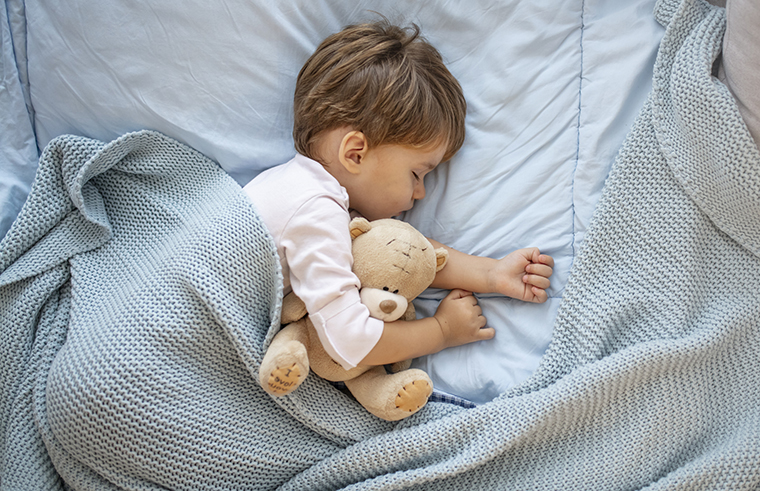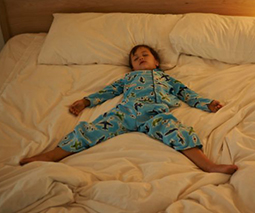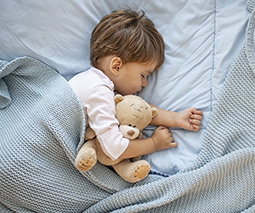8 expert tips to get your toddler to sleep in their own bed – every night!

When it comes to getting a toddler to sleep through the night, it isn’t a case of one way fits all.
Some of us choose to co-sleep, cope-sleep or go to battle with our tiny dictators night after night trying to get them to stay in their own beds.
Whatever your way, if no one is getting any sleep, it may be time to change things up.
Leading Australian ‘Baby Whisperer’, Katie Forsythe from The Baby Sleep Company says that parents need to feel confident to do what is best for their family without judgement.
“I co-sleep with my kids because I am a single mum and I have an au pair and I made the choice to have the kids in with me and free up the room for my au pair,” Katie says.
“It’s all well and good to be sleeping with your kids if they sleep well and if you’re actually co-sleeping and not cope-sleeping, which is kind of playing the short-term game of ‘let’s just do whatever gets us the most amount of sleep tonight.’
“Co-sleeping is more of an attachment parenting choice or, in my case, a convenience choice.”
The baby sleep project
Katie runs The Baby Sleep Project, an online sleep solution program designed specifically for children aged from six months to toddlers.
The program gives sleep-deprived parents instant access to support and guidance as they reclaim their slumber and help their little ones get the rest their growing bodies need.
“We found most parents leave it until they are at absolute breaking point before reaching out for help so when they have to wait three weeks to get in it can be very depressing,” Katie says. “We believe in giving people options, there is not a one-size fits all.”
So if, like me, your toddler is regularly marching their way into your room to complete every night with an acrobatic or kickboxing routine in your bed, fear not.
Here’s Katie’s tips for getting your toddler out of your bed and back into theirs.
1. Sleep regression
Sleep regression is common and often occurs when something happens to upset the usual sleep routine like a short period where the toddler is encouraged to co-sleep.
Katie says family holidays away, house guests changing the sleeping arrangements, or periods when a child is sick can cause even the best sleepers to fight attempts to get them back into the usual routine.
“The most important thing with sleep regression is being able to draw a line in the sand and say, ‘OK, that was then, you were sick or we were on holidays or the visitors are gone, and your room is now available again’,” Katie says.
2. Room reintroduction

Katie says parents need to make it clear to their toddler where their safe sleep space is.
“My first step to gently ease them back into their room would be to continue to co-sleep with them but in their room,” Katie says.
“Toddlers often refer to their parents room as ‘my room’ or ‘our room’ and so you want that toddler to identify their room as being their safe space.
“Of course you don’t have to do it in a gentle way but, if you want to do it gently, this is what I would recommend. It could involve putting a single mattress next to their bed or whatever works.”
3. Create an ideal environment
If parents want their child to sleep in a certain room, Katie says it helps if the parents put themselves in the space and see how it makes them feel.
“Sometimes it is important to just lay down in your toddler’s bed and take a look around,” she says.
“Is it quite a busy view from here, can I see open cupboards or a messy bookcase? We don’t like walking into a messy, upside-down room; that’s not a calming or soothing effect for someone to be going to sleep in.”
Katie says it’s also important to remember children around the age of two are starting to develop the emotion of fear.
“Where a baby up to 18 months or older might have been totally fine with a room being pitch black with the door shut, a toddler often will not be and it’s important to address that,” Katie says.
4. Light source
If you are going to have a nightlight, Katie says to avoid white, blue or green lights.
“You want a red or pink or amber night light because that has the least amount of blue light in it,” she says.
“It’s blue light that interferes with the secretions of melatonin. Blue light hits our eyeballs and hits our body clock and that is what governs our circadian rhythm.”
5. Comfort matters

Just like us, children like to be comfortable when they sleep but Katie says this is often overlooked by parents.
“The thing is that sleep-deprived people do not think very clearly,” Katie says. “I had a consultation once with a family and a three-year-old was sleeping with the mum, in the mum’s bed. I asked her, ‘Are you sleeping together in her bed or your bed?’, and her response was, ‘Oh god no. We don’t sleep in her bed, it’s so uncomfortable, it’s so hard’.
“I looked at her and said, ‘If you prefer sleeping in your bed, perhaps your daughter prefers sleeping in your bed for the same reason’.
“This is what we all do, we go and buy the second cheapest mattress – not the cheapest because then we’re a bad parent! So, if you’ve done this, maybe go and get a mattress topper and make the bed comfortable. Mammals need nests, they like having nests, comfort matters.”
While parents don’t need to spend a fortune on bedding, Katie recommends avoiding cheap polyester sheets even if they have the cutest print.
“If you don’t find them comfortable, the chances are neither will your toddler,” she says.
6. Ease yourself out
Katie says when toddlers are settled and comfortable in their beds, parents can start easing themselves out.
“Start by sitting with them while they go to sleep and then leave, but making sure to go back in if they wake and are upset,” Katie says. “The important thing is they know mummy and daddy are here for them but we are just not doing what we used to do.”
7. Be firm but fair

Katie says toddlers need boundaries but they must be fair.
“I am not an advocate for just shutting the door and not going back all night,” Katie says. “I think that is very old school and I don’t think that is fair on a toddler. My mantra with toddlers is always firm but fair.”
“Toddlers need boundaries but they also need to be fair. Is it fair to just shut the door and not go back? Certainly not. But, is it fair to expect them to stay in their room? Yes it is fair, but ‘I’m going to support you through that’.”
8. Small and gradual changes
Change may not happen overnight, and this is OK, Katie says.
“Don’t expect everything to be fixed in one night – we are talking about little people with really big emotions so it is going to take time,” she says. “But remember you are going to have to be persistent and consistent.”









